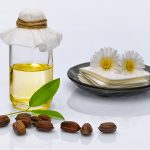
Lavender is a popular garden plant and a great attractor of bees. The oil is also noted for its fine aroma and calming properties. All lavender comes from a single genus called Lavandula in the nettle family or Labiatae (Lamiacae). It contains at least 47 species. They are all perennials.
Three or four of those species, including one hybrid are commonly used for manufacturing essential Lavender oils.
Most of the species originate from northern Africa and the Mediterranean mountains. It is a plant for its summer colour and heady fragrance. The plant is also grown commercially in India such as the Kashmir valley. It is also one of the main flowers for attracting bees and the honey is especially sought after.
One of the most important commercially grown species is Lavandula angustifolia ssp. angustifolia Mill. and Lavandula hybrida Rev.
The oil is traditionally believed to be antibacterial, an antifungal, a carminative which means smooth muscle relaxant, sedative, antidepressive and an effective treatment for burns and insect bites. The various activities have been reviewed by Cavanagh and Wilkinson (2002).
Composition Of Lavender Oil
Lavender oil is produce by steam distillation from both the flower heads and the foliage. the chemical compositions from different parts of the plant differ. The more fragrant oil is obtained from the flower heads.
Lavender oil from L. augustifolia mill. obtained from India contained 2.8% oil w/w fresh. The oil was an anlysed by capillary gas chromatography (GC) and GC–mass spectrometry
(MS) (Verma et al., 2010). Thirty seven constituents, representing 97.81 % of the oil were identified. The major components of the oil were linalyl acetate (47.6%), linalool (28%), lavandulyl acetate (4.34 %) and α-terpineol (3.75 %).
Uses Of Lavender Oil
- A calming relaxing oil used to combat stress and anxiety.
- The oil has strong antiseptic and antimicrobial properties.
- Can help relieve symptoms of flu, colds and other rheumatic complaints. Has similar uses to peppermint oil.
- Used sparingly in cooking but it is highly pungent.
*Do not ingest directly as it is toxic when consumed.
There is not enough evidence yet to recommend it being used to treat depression, hypertension (high blood pressure), menstrual pain, nausea or skin conditions like eczema.
Lavender oil is not approved by the Food And Drug Administration and is not to be used in place of any approved or prescribed medicines. It is only available as a supplement. There is however plenty of ongoing research to examine the efficacy of the oil in treating many conditions. It is likely in due course that many conditions will have much firmer evidence available to support the benefits of lavender oil.
Silexan
Silexan is a supplement of lavender oil in gelatine capsules. It is available in these capsules in 80mg amounts.
Antimicrobial Effects Of Lavender Oil
Lavender oil was reported to be an effective antifungal agent against Aspergillus nidulans and Trichophyton mentagrophyte (Moon et al., 2004).
Clinical Evidence
Treatment For Anxiety
At the moment there are very few large-scale clinical studies to examine the effect of lavender on people and anxiety but there are some studies beginning to reveal possible benefits in this particular area.
The treatment for Generalized Anxiety Disorder is normally managed by drug medication. There is renewed interest in more natural products because many of the drugs have serious side effects. Benzodiazepam for example is frequently administered, the concern being that it causes heavy sedation with a the potential for drug abuse.
Lavender oil does not have a sedative effect and is well-tolerated.
Small-scale clinical trials and pharmacology studies have shown that lavender is a possible treatment. One clinical study compared a lavender based product called silexan with the drug lorazepam. Participants took an oral supplement of either one or the other over a six week period. They looked at changes in the Hamilton Anxiety Rating Scale. At the end of the trial period, both groups reported an almost identical decrease in anxiety levels of 45% and 46%, respectively.
The overriding conclusion was that silexan was as effective as lorazepam in adults dealing with GAD. It appears to serve as an effective alternative according to this study to benzodiazepam in treating general anxiety (Woelk & Schläfke, 2010).
A substantial review published in the International Journal of Psychiatry in Clinical Practice looked at the benefits of Silexan in patients with a variety of anxiety disorder (Kasper, 2013). This preparation was found to produce an anxiety-reducing effect on patients with generalized or subsyndromal anxiety with a fortnight of application.
The application of lavender oil also helps reduce anxiety in dental patients (Kritsidima et al., 2010). Apparently, the anxiety felt by those in the waiting room awaiting their appointment were more becalmed when exposed to lavender scent compared to those who were not. The lavender scent helped calm the patients irrespective of the type of appointment they were expecting.
It seems that Lavender does not necessarily help reduce anxiety concerning visits in the future but appears to instil calm when attending a treatment.
Memory Issues Could be resolved By Administering Lavender Oil
In animal studies, lavender oil can reverse spatial memory defects. A study in rats which had been treated with scopalamine induced a form of dementia (Hritcu et al., 2012). Chronic exposure to lavender essential oils on a daily basis for 7 continuous days not only reduced the rats’ anxiety behaviour but also improved their spatial memory. The implication here was that the lavender oil was ameliorating the damage in the cholinergic system in the rat brain and helping to manage neurological issues in a dementia like situation.
Products
Please note this page contains links to our affiliate marketing partner. Please read our affiliate disclosure.
References
Cavanagh, H. M. A., & Wilkinson, J. M. (2002). Biological activities of lavender essential oil. Phytotherapy research, 16(4), pp. 301-308 (Article).
Hritcu, L., Cioanca, O., & Hancianu, M. (2012). Effects of lavender oil inhalation on improving scopolamine-induced spatial memory impairment in laboratory rats. Phytomedicine, 19(6), pp. 529-534 (Article)
Kasper, S. (2013). An orally administered lavandula oil preparation (Silexan) for anxiety disorder and related conditions: an evidence based review. International Journal of Psychiatry in Clinical Practice, 17 (sup1), pp. 15-22 (Article).
Kritsidima, M., Newton, T., & Asimakopoulou, K. (2010). The effects of lavender scent on dental patient anxiety levels: a cluster randomised‐controlled trial. Community Dentistry and Oral Epidemiology, 38(1), pp. 83-87 (Article).
Moon, T., Chan, Y.F., Wilkinson, J.M., Cavanagh, H.M.A. (2004) In: Proceeding of AICA National Conference, Adelaide, Australia, 2004, pp.46.
Verma, R. S., Rahman, L. U., Chanotiya, C. S., Verma, R. K., Chauhan, A., Yadav, A., … & Yadav, A. K. (2010). Essential oil composition of Lavandula angustifolia Mill. cultivated in the mid hills of Uttarakhand, India. Journal of the Serbian Chemical Society, 75(3), pp. 343-348.
Woelk, H., & Schläfke, S. (2010). A multi-center, double-blind, randomised study of the Lavender oil preparation Silexan in comparison to Lorazepam for generalized anxiety disorder. Phytomedicine, 17(2), pp. 94-99 (Article).
Revision: Addition of new material on benefits associated with reducing anxiety, material on composition and other sundry additions.

Leave a Reply